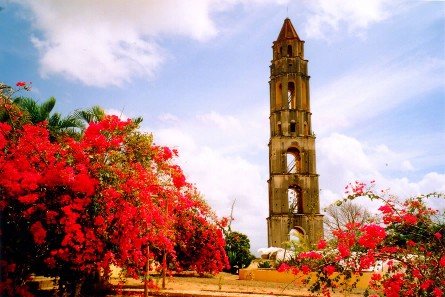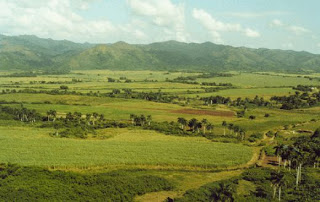Sancti Spíritus is a municipality and capital city of the province of Sancti Spíritus in central Cuba. Sancti Spíritus, Latin for “Holy Spirit,” is one of the best preserved cities in the Caribbean from the time of the sugar trade.
The city was founded by Diego Velázquez de Cuéllar in 1514. Francisco Iznaga, a rich Basque landowner in the western portion of Cuba during the first thirty years of the colonization of Cuba, was elected mayor of Bayamo in 1540. Iznaga was the originator of a powerful lineage that finally settled in Sancti Spiritus and Trinidad where Torre Iznaga is. Iznaga’s descendants fought for the Independence of Cuba and some of the family members lobbied to bring Annexation to the US instead of full independent as the people of Cuba fought for more than 30 years.
The Parroquial Mayor is located two blocks south of the town’s main square; it is a venerable green-towered church whose early 16th-century origins make it the country’s oldest. Nearby is the Museo de Arte Colonial (Colonial Art Museum), one of Sancti Spíritus’s most splendid colonial homes and a standout attraction. The opulent former palatial mansion of the Valle Iznaga clan, one of Cuba’s most elite families who fled Cuba after Fidel Castro’s Revolution, it became the property of the state in 1961. Ninety percent of what you see inside, from furniture to paintings, is original. Though the family obviously kept an impressive collection of Limoges porcelain, French gilded mirrors, Italian marble tables, and Baccarat crystal chandeliers here, it wasn’t their primary residence; the house was used mostly to host family members in transit, so the furnishings were rather eclectic. The three bedrooms are decorated in grand style, though, with handmade lace, embroidered sheets, and hand-painted glass. There is a gorgeous and very Cuban leather sillón fumador (smoking chair) and, in the music room, the mid-18th-century American piano, one of only two of its type in Cuba.
Near the city is the San Luis Valley or Valley of the Sugar Mills, museum of Cuban sugar industry 75 ruins of sugar mills, summer houses, barracks and other facilities related to the production of fresh product, the principal product of export that has been become a disaster after the Castro Administrations.
Trinidad, also known as the City Museum of Cuba is one of the most beautiful colonial cities of the island, founded in 1514 under the name of Villa of the Holy Trinity, and received the status of a World Heritage Site by UNESCO to be considered one of the architectural complexes in the Americas. Trinidad combines features of the eighteenth and nineteenth and early twentieth centuries, so tours of its cobbled streets lead visitors to discover their artistic balconies, blacksmith works admirably worked, stairways and colorful facades of buildings, each one a museum in itself.
They are unique to Plaza Mayor, where it is believed to have traveled in time, or the church of the Holy Trinity, considered one of the largest in the country and that holds valuable pieces of religious art treasury Cuba, including the famous Christ Vera Cruz, and a marble altar dedicated to the cult of the Virgin of Mercy-only of its kind on the island-, and other religious images of great value cultural offerings are completed with samples of museums Romance – installed in the old Palacio Brunet-and Archaeology “Guamuhaya” exponent of the aboriginal culture of the island.
All complemented by the detail of the famous Manaca-Iznagas tower, built in 1816 with its 45 meters high with its bell marked the start and end of the work in the plantations of sugar cane. The area also includes the protected natural landscape “Topes de Collantes” in the Escambray Mountains, with about 12 500 hectares and numerous endemic species of flora and fauna, where the rainy climate that favors life of orchids, mosses, lichens, ferns, pines and eucalyptus.
Another interesting landmark is one of Cuba’s older bridges over the Yayabo river. Built in 1815 with clay bricks it forms five arcs, the center being 9 meters tall. The entire bridge is only 85 meters long and was designed for pedestrians and carriages during colonial-era Cuba but has thus far resisted heavier modern traffic.
Sancti Spíritus has a worldwide famous Medical University located at the Main road in Olivos III. It has students from all over the world representing 34 nationalities. It is also the home of the Sancti Spíritus Gallos baseball team.
The municipality is divided into the barrios of Banao, Bellamota, Bijabo, Guasimal, Hospital, Jíbaro, Manacas, Mapos, Paredes, Paula, Pelayo, Pueblo Nuevo, San Andrés, Tuinicú, Tunas de Zaza and Zaza del Medio. The Zaza Reservoir is located southwest of the city.
The city has a central park which is a place of great entertainment for the persons of all ages.
In 2004, the municipality of Sancti Spiritus had a population of 133 843. The population has not grown enough because of its strong emigration overseas and other provinces. With a total area of 1,151 km2 (444 square miles), this means a population density of 116.3 / km 2 (301/sq mi).
Sources: Wiki/InternetPhotos/www.thecubanhistory.com
SANCTI SPIRITUS: Beautiful and Historical
The CUban History, Arnoldo Varona,Editor
Foto Heriberto Magdaleno, Libia Changerotti. – l Morro de la Habana.

SANCTI SPIRITUS: BELLEZAS E HISTORIA JUNTAS
Sancti Spíritus es un municipio y capital de la provincia de Sancti Spíritus, en el centro de Cuba . Sancti Spíritus , en latín significa ” Espíritu Santo”, es una de las ciudades mejor conservadas del Caribe desde la época del comercio de azúcar.
La ciudad fue fundada por Diego Velázquez de Cuéllar en 1514 . Francisco Iznaga , un rico terrateniente vasco en la parte occidental de Cuba durante los primeros treinta años de la colonización de Cuba , fue elegido alcalde de Bayamo en 1540. Iznaga fue el creador de un poderoso linaje que finalmente se estableció en Sancti Spíritus y Trinidad , donde Torre Iznaga es . Descendientes de Iznaga lucharon por la independencia de Cuba y algunos de los miembros de la familia presionaron para lograr la anexión de los EE.UU. en lugar de la plena independencia como pueblo de Cuba lucharon durante más de 30 años.
La Parroquial Mayor se encuentra a dos cuadras al sur de la plaza principal de la ciudad , es una iglesia verde torres venerable cuyos orígenes tempranos 16th-century que sea más antiguo del país . Muy cerca se encuentra el Museo de Arte Colonial ( Museo de Arte Colonial) , una de las más espléndidas casas coloniales de Sancti Spíritus y una atracción estelar . La opulencia antigua mansión palaciega del clan de Valle Iznaga , una de las familias de élite de Cuba que huyeron de Cuba después de la Revolución de Fidel Castro , pasó a ser propiedad del Estado en 1961 . El noventa por ciento de lo que se ve en el interior, desde muebles hasta cuadros, es original. Aunque la familia , obviamente, mantiene una impresionante colección de porcelana de Limoges , espejos dorados franceses , mesas de mármol italiano y lámparas de araña de cristal de Baccarat aquí , que no era su residencia principal , la casa se utiliza sobre todo para alojar los miembros de la familia en tránsito, por lo que los muebles eran bastante ecléctico . Las tres habitaciones están decoradas con gran estilo , sin embargo, con el cordón hecho a mano, sábanas bordadas , y vidrio pintado a mano . Hay un precioso y muy cubana de cuero sillón Fumador ( silla de fumar) , y en la sala de música , el piano de América a mediados de siglo 18 , uno de los dos únicos de su tipo en Cuba .
Cerca de la ciudad se encuentra el Valle de San Luis o Valle de los Ingenios , museo de la industria azucarera cubana 75 ruinas de ingenios , casas de verano , barracones y otras instalaciones relacionadas con la producción de productos frescos , el principal producto de exportación que se ha convertido en un desastre después de Castro Administraciones.
Trinidad , también conocida como la Ciudad Museo de Cuba es una de las ciudades coloniales más bellas de la isla , fundada en 1514 bajo el nombre de Villa de la Santísima Trinidad , y recibió el estatus de Patrimonio de la Humanidad por la UNESCO para ser considerada una de los complejos arquitectónicos de las Américas. Trinidad combina características de los siglos XVIII y XIX y principios del XX , por lo giras por sus calles empedradas conducen a los visitantes a descubrir sus balcones artísticas , herrero trabaja admirablemente trabajadas , escalinatas y fachadas coloridas de edificios , cada uno de un museo en sí mismo.
Ellos son únicos a la Plaza Mayor, donde se cree que ha viajado en el tiempo, o la iglesia de la Santísima Trinidad, considerada una de las más grandes del país y que mantiene valiosas piezas de arte religioso de tesorería Cuba , entre ellos el famoso Cristo Vera Cruz y un altar de mármol dedicado al culto de la Virgen de la Misericordia – único de su tipo en la isla – , y otras imágenes religiosas de gran oferta cultural de valor se completan con muestras de museos Romance – instalado en el antiguo Palacio Brunet y Arqueología exponente ” Guamuhaya ” de la cultura aborigen de la isla.
Todo ello complementado por el detalle de la famosa torre de Manaca – Iznaga , construida en 1816 , con sus 45 metros de altura con su campana marcó el inicio y el final de la obra en las plantaciones de caña de azúcar. El área también incluye el paisaje natural protegido ” Topes de Collantes ” en las montañas del Escambray , con cerca de 12 500 hectáreas y numerosas especies endémicas de flora y fauna , donde el clima lluvioso que favorece la vida de las orquídeas , musgos , líquenes , helechos , pinos y eucalipto .
Otro punto de referencia interesante es uno de los puentes más antiguos de Cuba sobre el río Yayabo . Construido en 1815 con ladrillos de arcilla que forma cinco arcos , el centro es de 9 metros de altura. Todo el puente está a sólo 85 metros de longitud y fue diseñado para los peatones y carruajes durante la época colonial, Cuba , pero se ha resistido hasta ahora el tráfico pesado moderno.
Sancti Spíritus tiene un mundialmente famosa Universidad Médica ubicada en la carretera principal en Olivos III . Cuenta con estudiantes de todo el mundo que representan a 34 nacionalidades . Es también el hogar del equipo de béisbol de Gallos Spíritus Sancti .
El municipio se divide en los barrios de Banao , Bellamota , Bijabo , Guasimal , Hospital, Jíbaro , Manacas , Mapos , Paredes, Paula, Pelayo , Pueblo Nuevo , San Andrés , Tuinicú , Tunas de Zaza y Zaza del Medio. El embalse Zaza se encuentra al suroeste de la ciudad.
La ciudad cuenta con un parque central, que es un lugar de gran entretenimiento para las personas de todas las edades .
En 2004, el municipio de Sancti Spíritus tenía una población de 133.843. La poblacion no ha crecido lo suficiente debido a su fuerte emigracion al extranjero y otras provincias. Con una superficie total de 1.151 km2 (444 millas cuadradas), Esto significa una densidad poblacional de 116,3 / km2 (301/sq mi) .
Sources: Wiki/InternetPhotos/www.thecubanhistory.com
SANCTI SPIRITUS: Beautiful and Historical
The CUban History, Arnoldo Varona,Editor



 © SANCTI SPIRITUS: Beautiful and Historical (Photos) * * SANCTI SPIRITUS: Bellezas e Historia Juntas (Fotos).
© SANCTI SPIRITUS: Beautiful and Historical (Photos) * * SANCTI SPIRITUS: Bellezas e Historia Juntas (Fotos).
